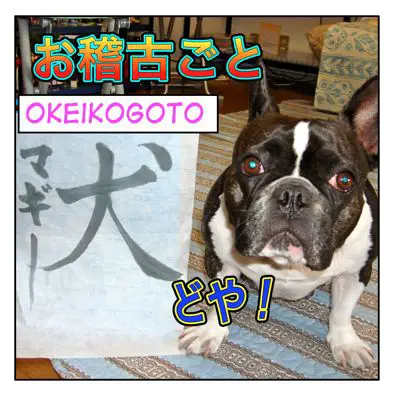Today’s lesson is about Japanese culture more than languages.
It’s お稽古ごと = okeikogoto = cultural (hobby) lesson
稽古 = keiko means to practice something
verb form is 稽古する ( = keiko suru)
Ex. ヴァイオリンを稽古する
= Baiorin wo keiko suru.
= to practice the violin
Customarily women often add “お” ( = o ) in front of 稽古 ( = keiko)
Ex. 今日はピアノのお稽古をしないといけない。
= Kyou wa piano no okeiko wo shinai to ikenai.
= I have to practice on piano today.
Ex. 相撲の稽古
= sumou no keiko
= Practice Sumo / train for Sumo
It is usually used for Japanese martial arts. It would be a bit strange to use this for modern sports such as サッカー ( = sakkaa ) soccer, テニス ( = tenisu ) tennis , バレーボール ( = bareebooru) volleyball. etc. We use 練習 ( = renshuu) instead.
Ex. 舞台稽古
= butai geiko
= stage rehearsal / to have a dress rehearsal
Now look at the picture above. I say,
“どや! ” ( = Doya!) which is Osaka dialect for “How’s that!” proudly when you show off something.
Check どや顔 = doyagao = lesson
and I am showing my 習字 ( = shuuji) Japanese calligraphy
(I wrote “犬” ( = inu) dog and her name, マギー ( = Maggie )
Japanese children learn traditional calligraphy at school, but some children go to a special school to learn calligraphy to improve
their penmanship.
Many children take educational cultural lessons such as piano, violin, ballet, English, etc. even at at a very young age in Japan.
Those cultural lessons for your hobby are called (お)稽古ごと ( = (o)keikogoto) ( お ( = o) adds politeness.) or 習い事 ( = naraigoto)
:: Common お稽古ごと ( = okeikogoto) for children
★英会話 = eikaiwa = English (conversation)
★体操 = taisou = exercise class
★そろばん = soroban = abacus
★水泳 = suiei / スイミング = suimingu = swimming
★絵画 = kaiga = painting
★空手 = karate = Karate
★ピアノ = piano = piano
★バレエ = barei = ballet
★サッカー = sakkaa = soccer
Note:
1) Usually the location of the lessons is called as スクール or 教室 ( = sukuuru or kyoushitsu)
Ex. 体操教室 = taisou kyoushitsu = Exercise class,
Ex. 英会話スクール = eikaiwa sukuuru = English school
2) There are classes targeting very young age called 幼児クラス = youji kurasu = infant class.
3) 学習塾 = gakushuujuku = cram schools are not counted as (お)稽古ごと = (o)keikogoto.
4) They take one or two (or more) cultural lessons a week after school.
We have more choices now but お稽古ごと ( = okeikogoto) has been in Japan for a long time.
Ex. 「おたくのお子さんは何かお稽古ごとをさせていますか?」
= Otaku no okosan wa nanika okeiko goto wo sasete imasuka?
= Do you make your children take any lessons?
Ex. 「うちは、何もお稽古ごとをさせていません。」
= Uchi wa nanimo okeigototo wo sasete imasen.
= We don’t make our children (child) take any lessons.
Ex. 「うちは週3回、お稽古ごとをさせています。」
= Uchi wa shuu sankai okeikogoto wo sasete imasu.
= We make our child(ren) take lessons three times a week.
Ex. 「今日はピアノのお稽古があるからもう帰らないと。」
= Kyouwa piano no okeiko ga arukara mou kaeranaito.
= I have a piano lesson so I have to go home now.
お稽古ごと = okeikogoto = is not not just for children. Adults (usually for women) do お稽古 ( = okeiko) (also called as 習い事 ( = nariagoto) ) as well and
there is even magazines or sites for お稽古ごと ( = okeikogoto ) listening up all the cultural l lessons.
The traditional one is お茶 ( = ocha ) = tea ceremony, お花 ( = ohana) , or 生け花 ( = ikebana ) flower arrangement
They used to be essential for 花嫁修業 ( = hanayome shugyou ) training to become a good wife.
Now a days, お稽古ごと ( = okeikogoto) varies and many of women take lessons not just for fun but also to improve their special skill and make it useful
to get the better job.
There are a lot of スクール ( = sukuuru) or 教室 ( = kyoushtisu ) = schools which provides variety of subjects.
But the word お稽古ごと ( = okeikogoto) or 習い事 ( = naraigoto) usually lacks for
The list of common お稽古ごと ( = okeikogoto)
★英会話 = eikaiwa = English conversation
(フランス語 = furansu go , 韓国語 = kankokugo = Korean
(Note : Learning Korean has been very popular among Japanese because of K-Pop and popular TV or movie stars.)
イタリア語 = itaria-go, 中国語 = chuugoku-go = Chinese etc.)
★絵画 = kaiga = paiting
★ヨガ = yoga
★ゴルフ = gorufu = golf
★テニス = tenisu = tennis
★フラメンコ = furamenko = flamenco
★フラダンス = furadansu = Hula dance
★ギター = guitaa = guitar
★ピアノ = piano
★ボイストレーニング= boisu toreiningu = voice training
★料理 = ryouri = cooking
★お菓子作り = okashi zukuri = baking sweets
★写真 = shashin = photograph
★占い = uranai = fortune teller
★ガーデニング = gaadeningu = gardening
★ ジュエリーデザイン = juerii dezain = jewelry design
★アロマ= aroma = aroma therapy
★着付け = kitsuke = how to put on kimono
Note : お稽古ごと ( = okeikogoto) is also called as 習い事 ( = naraigoto)
Usually languages are called as 習い事 ( = naraigoto)
the verb is 習う ( = narau) = to learn
Ex. 今月はお稽古ごとで忙しい。
= Kongetsu wa okeiko goto de isogashii.
= I have been busy with all the (cultural ) lessons.
Ex. お稽古ごとが多くてお金がない。
= Okkeiko goto ga ookute okane ga nai.
= I am running out the money because of all the cultural lessons.
Ex. 今、何か習っている? or 習い事してる?
= Ima nanika naratte iru? or naraigoto shiteru?
= Are you taking any classes now?
Ex. 英会話を習っています。
= Eikaiwa wo naratte imasu.
= I am taking English lessons.
Note :
* If a man takes a cultural class, do we call it as お稽古ごと ( = okeikogoto) ?
It is possible but it may sound a bit feminine.
2) Basically 稽古する ( = keiko suru) is to practice and 習う ( = narau) is to learn something 〜を習っている ( = 〜wo naratte iru ) I am taking 〜
or we say
〜の教室 (or スクール)に通っている
= 〜no kyoushitsu (or sukuuuru) ni kayotteiru
= I go to 〜 school.
 マギー先生より = Maggie Sensei yori = From Maggie Sensei
マギー先生より = Maggie Sensei yori = From Maggie Sensei
みんなの国にはこういうお稽古ごとや習い事の習慣はありますか?
= Minna no kuni niwa kouiu okeikogoto ya naraigoto no shuukan wa arimasuka?
= Do you have this kind of custom of taking cultural classes in your country?
***
Will you be my Patron?
I appreciate your support! サポートありがとう!


7 Comments
Hi Maggie sensei, thank you very much for the lessons!! May I ask you a question? In your example above, “おたくのお子さんは何かお稽古ごとをさせていますか?” means “Do you make your children take any lessons?”. However, I learnt from another sensei that “watashi wa kato-san ni unten saseru” means “I make/let kato san drive”. In your example, “your children” is in front of は, but in his example “I” is in front of は. I am sure both examples are correct, but why the difference? In one example, the “weaker” person is in front of wa, but in the other example, the “stronger” one is in front of wa.
Thanks!!
Hi Kahloon
Right, Someoneに〜をさせる (あなたは、お子さんに何かお稽古事をさせていますか) is the correct form.
If you study for the JLPT exam, you stick to the form.
But in conversation, when you talk about something in this case your children, you introduce the topic with は
As for your children, do you make them take any lesson?
I will show you other simple example.
You say
あなたは朝食をもう食べましたか?
Did you already have breakfast?
You use を for breakfast because it’s an object of an action, eating.
But when you present breakfast as a topics, you change the particle with は
朝食はもう食べましたか?
(literal translation) As for breakfast, did you already have?
Also you often omit the subject あなた.
こんばんは\(^o^)/
This is my first time reading Maggie Sensei’s blog and i really like it. The post is full of knowledge and people will not have chance to learn this in class i guess (im not attending any japanese class though. Hehe).
I think there is お稽古事 in my country but its not that popular that your neighbour/friends will ask you about your children’s お稽古事…
My final exam starts this saturday! Reading your blog in between my studies is fun! Keep me awake. Thanks!! Okay i better go now Brain Tumours note is ‘glaring’ at me nowε=ε=ε=ε=ε=ε=┌(; ̄◇ ̄)┘
@アリナ
Hi, thank you for visiting this site. I am glad to hear you like it.
Good luck for your final exam! Please come back between your studies. :)
Sorry about the dates at the start, I accidentily copy/pasted them-_-‘ Disregard those please^_^’
こんにちは、Maggie-sensei, I’ve been lurking your blog for quite some time now>_> And have finally decided to post and say ありがとう for such a すてきな Blog. It has been very helpful and it’s fun too! I was wondering could you try to post more lessons on slang?
More specifically things like slangy grammar contractions (ex. 〜えば becoming 〜や、 見ればー>みりゃ)?
I also liked the lesson where you used that song “There’s a Goddess in the Toilet”(?) to learn and explain grammar points. You should really do more of those:) Of course, when time permits…
Anyway, keep up the awesome work on the blog;) がんばってよ!
@ゾモチ
Thank you for visiting this site! Also thank you for your first comment! :h: I have posted a couple of lessons of casual contractions ~ ん+なきゃ/なくちゃ+, ちゃう+ちゃった,etc. But there are more. I will make more lessons in future.
Will find another interesting song to study with,too! Thank you for your feedback and please feel free to leave comments anytime!
(I erased the dates. )